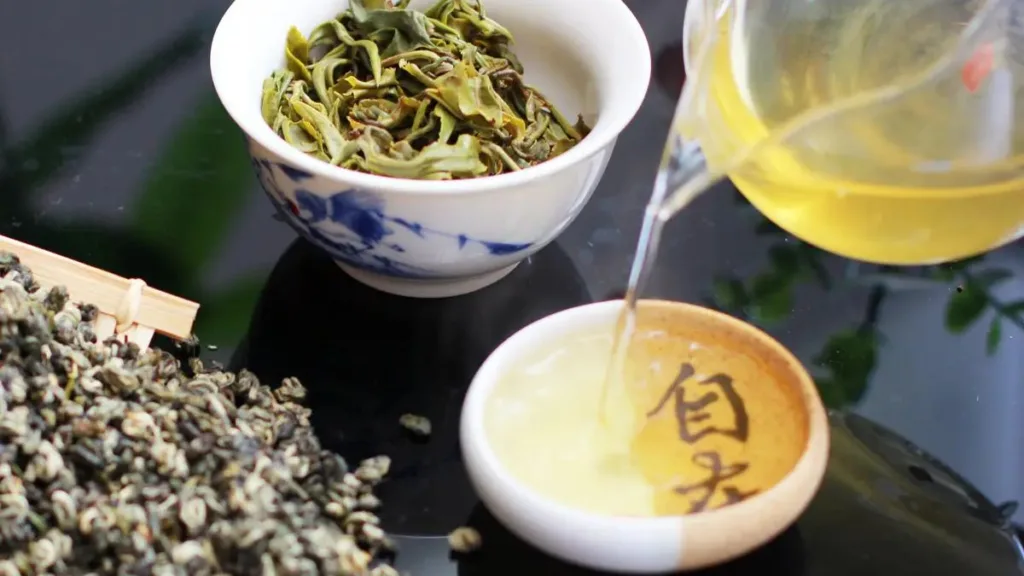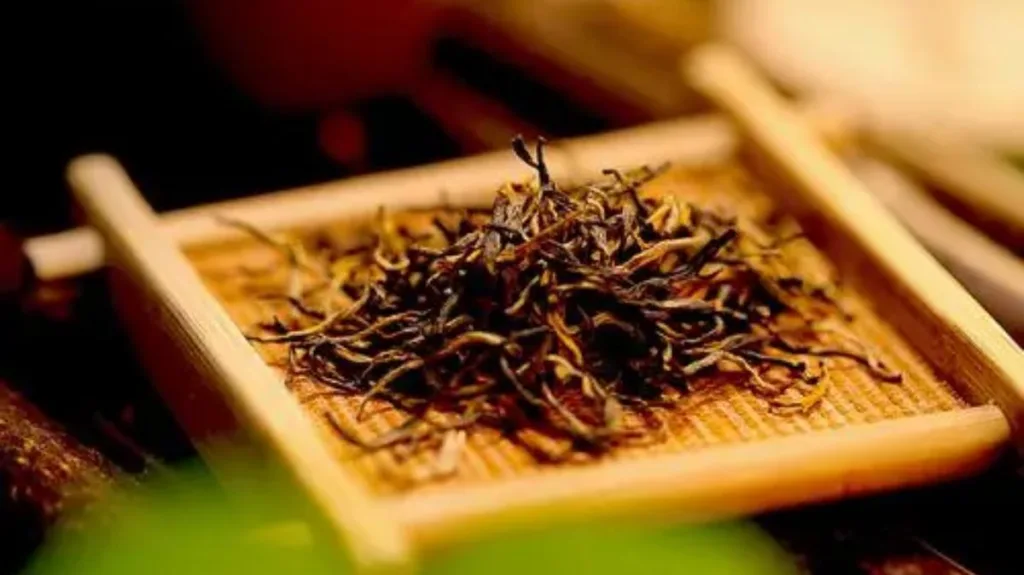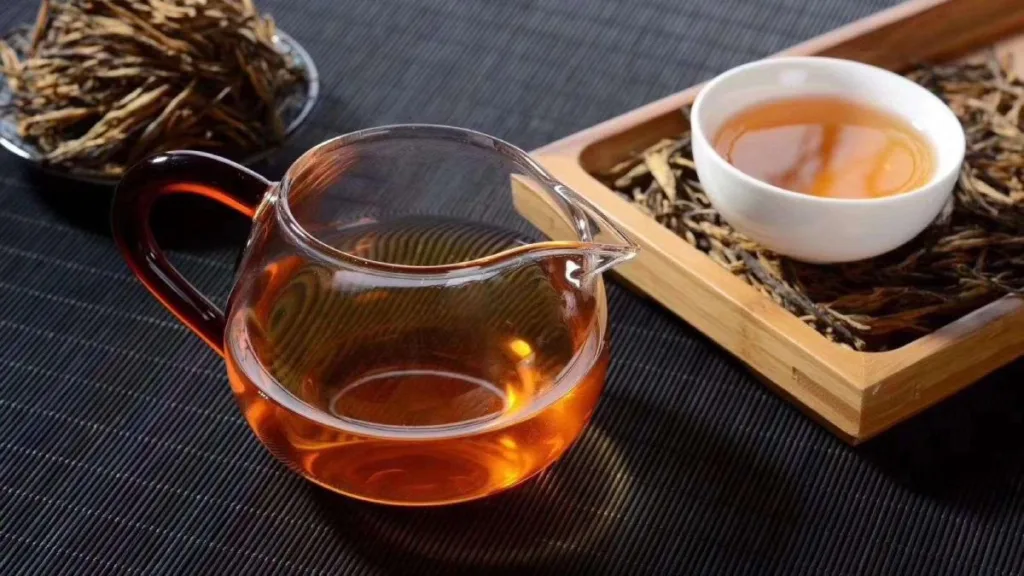Dragon Well tea, one of the most renowned varieties of flat-pressed green tea, is celebrated for its smooth, hairless appearance, refreshing aroma, crisp and sweet flavor, and a lingering, delicate aftertaste. With a long history of tea production, Dragon Well tea is considered a gem in the world of green teas. But what similar products are available?
Similar products to Dragon Well tea include Jinshan Cuíyá, Long Ding tea, and Wuniuzao.
- Jinshan Cuíyá:
 Jinshan Cuíyá, a specialty green tea from Zhenjiang City, Jiangsu Province, closely resembles Dragon Well tea. It boasts flat, uniform dry leaves with a greenish-blue color, bearing a striking resemblance to Dragon Well tea. Once steeped, Jinshan Cuíyá exhibits an enchanting, delicate fragrance akin to Dragon Well tea. However, the differences between the two are notable. For instance, Jinshan Cuíyá features clear tea fuzz on the surface of the dry leaves and has full, plump leaves after steeping. In contrast, Dragon Well tea is known for its smooth dry leaves, with tender, petite leaves after brewing.
Jinshan Cuíyá, a specialty green tea from Zhenjiang City, Jiangsu Province, closely resembles Dragon Well tea. It boasts flat, uniform dry leaves with a greenish-blue color, bearing a striking resemblance to Dragon Well tea. Once steeped, Jinshan Cuíyá exhibits an enchanting, delicate fragrance akin to Dragon Well tea. However, the differences between the two are notable. For instance, Jinshan Cuíyá features clear tea fuzz on the surface of the dry leaves and has full, plump leaves after steeping. In contrast, Dragon Well tea is known for its smooth dry leaves, with tender, petite leaves after brewing. - Long Ding Tea:
 Long Ding tea is one of the teas that shares a name similarity with Dragon Well tea. However, apart from the name, the two teas differ significantly. Dragon Well tea is produced in West Lake, Qiántáng, and Yuèzhōu in Zhejiang Province. It undergoes nine intricate processing steps, resulting in flat, straight leaves, a delicate, far-reaching aroma, and a refreshing, crisp flavor. In contrast, Long Ding tea is produced in Kaihua County, Zhejiang Province, and is known for its fine, needle-like appearance with only seven processing steps.
Long Ding tea is one of the teas that shares a name similarity with Dragon Well tea. However, apart from the name, the two teas differ significantly. Dragon Well tea is produced in West Lake, Qiántáng, and Yuèzhōu in Zhejiang Province. It undergoes nine intricate processing steps, resulting in flat, straight leaves, a delicate, far-reaching aroma, and a refreshing, crisp flavor. In contrast, Long Ding tea is produced in Kaihua County, Zhejiang Province, and is known for its fine, needle-like appearance with only seven processing steps. - Wuniuzao:
 Wuniuzao is another tea that bears a striking resemblance to Dragon Well tea. It is a type of green tea and is often mistakenly believed to be the same as Dragon Well tea due to a tea tree variety called “Wuniuzao” found in Dragon Well tea gardens. However, these two teas hail from different regions and have distinct characteristics. Wuniuzao tea is produced in Yongjia County, Zhejiang Province, and, despite its resemblance, it differs significantly in terms of origin, taste, and processing. Additionally, Wuniuzao tea is typically harvested from late February to early March each year, making it one of the early green teas.
Wuniuzao is another tea that bears a striking resemblance to Dragon Well tea. It is a type of green tea and is often mistakenly believed to be the same as Dragon Well tea due to a tea tree variety called “Wuniuzao” found in Dragon Well tea gardens. However, these two teas hail from different regions and have distinct characteristics. Wuniuzao tea is produced in Yongjia County, Zhejiang Province, and, despite its resemblance, it differs significantly in terms of origin, taste, and processing. Additionally, Wuniuzao tea is typically harvested from late February to early March each year, making it one of the early green teas.
While these teas can serve as substitutes for Dragon Well tea, they do not offer the exact same benefits. Therefore, it is advisable for individuals to make their choices based on their specific needs.

 Jinshan Cuíyá, a specialty green tea from Zhenjiang City, Jiangsu Province, closely resembles Dragon Well tea. It boasts flat, uniform dry leaves with a greenish-blue color, bearing a striking resemblance to Dragon Well tea. Once steeped, Jinshan Cuíyá exhibits an enchanting, delicate fragrance akin to Dragon Well tea. However, the differences between the two are notable. For instance, Jinshan Cuíyá features clear tea fuzz on the surface of the dry leaves and has full, plump leaves after steeping. In contrast, Dragon Well tea is known for its smooth dry leaves, with tender, petite leaves after brewing.
Jinshan Cuíyá, a specialty green tea from Zhenjiang City, Jiangsu Province, closely resembles Dragon Well tea. It boasts flat, uniform dry leaves with a greenish-blue color, bearing a striking resemblance to Dragon Well tea. Once steeped, Jinshan Cuíyá exhibits an enchanting, delicate fragrance akin to Dragon Well tea. However, the differences between the two are notable. For instance, Jinshan Cuíyá features clear tea fuzz on the surface of the dry leaves and has full, plump leaves after steeping. In contrast, Dragon Well tea is known for its smooth dry leaves, with tender, petite leaves after brewing. Long Ding tea is one of the teas that shares a name similarity with Dragon Well tea. However, apart from the name, the two teas differ significantly. Dragon Well tea is produced in West Lake, Qiántáng, and Yuèzhōu in Zhejiang Province. It undergoes nine intricate processing steps, resulting in flat, straight leaves, a delicate, far-reaching aroma, and a refreshing, crisp flavor. In contrast, Long Ding tea is produced in Kaihua County, Zhejiang Province, and is known for its fine, needle-like appearance with only seven processing steps.
Long Ding tea is one of the teas that shares a name similarity with Dragon Well tea. However, apart from the name, the two teas differ significantly. Dragon Well tea is produced in West Lake, Qiántáng, and Yuèzhōu in Zhejiang Province. It undergoes nine intricate processing steps, resulting in flat, straight leaves, a delicate, far-reaching aroma, and a refreshing, crisp flavor. In contrast, Long Ding tea is produced in Kaihua County, Zhejiang Province, and is known for its fine, needle-like appearance with only seven processing steps. Wuniuzao is another tea that bears a striking resemblance to Dragon Well tea. It is a type of green tea and is often mistakenly believed to be the same as Dragon Well tea due to a tea tree variety called “Wuniuzao” found in Dragon Well tea gardens. However, these two teas hail from different regions and have distinct characteristics. Wuniuzao tea is produced in Yongjia County, Zhejiang Province, and, despite its resemblance, it differs significantly in terms of origin, taste, and processing. Additionally, Wuniuzao tea is typically harvested from late February to early March each year, making it one of the early green teas.
Wuniuzao is another tea that bears a striking resemblance to Dragon Well tea. It is a type of green tea and is often mistakenly believed to be the same as Dragon Well tea due to a tea tree variety called “Wuniuzao” found in Dragon Well tea gardens. However, these two teas hail from different regions and have distinct characteristics. Wuniuzao tea is produced in Yongjia County, Zhejiang Province, and, despite its resemblance, it differs significantly in terms of origin, taste, and processing. Additionally, Wuniuzao tea is typically harvested from late February to early March each year, making it one of the early green teas.

